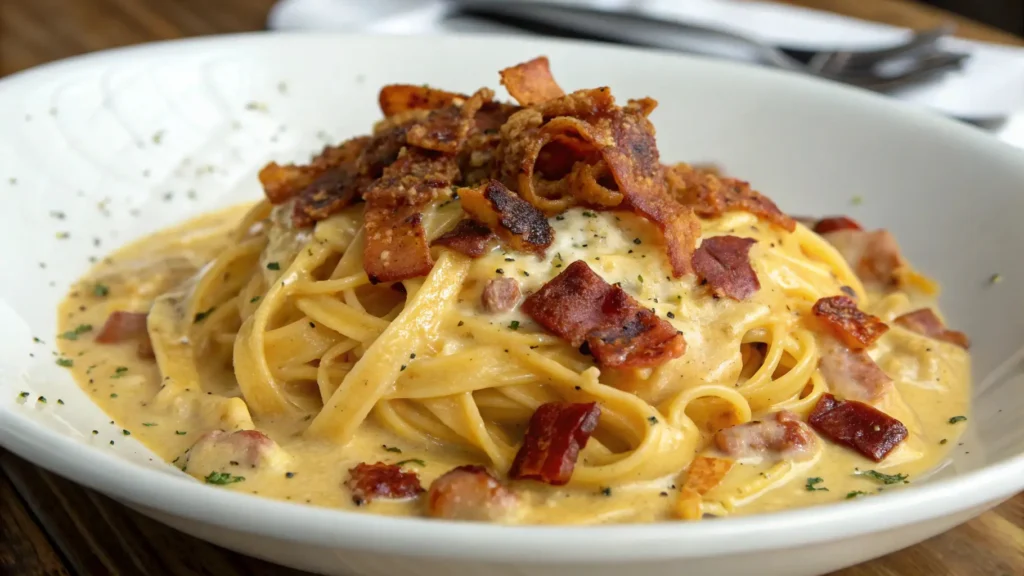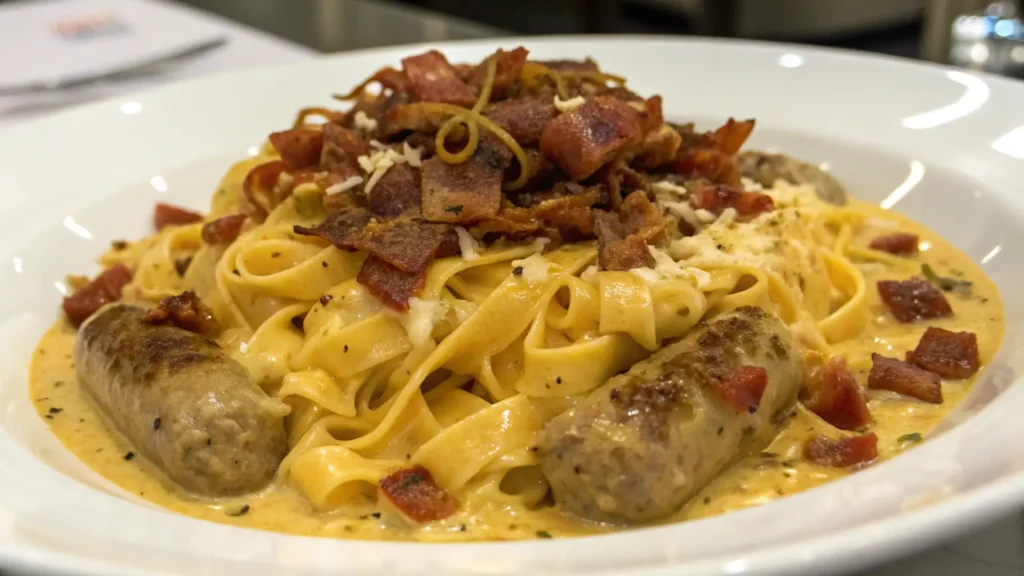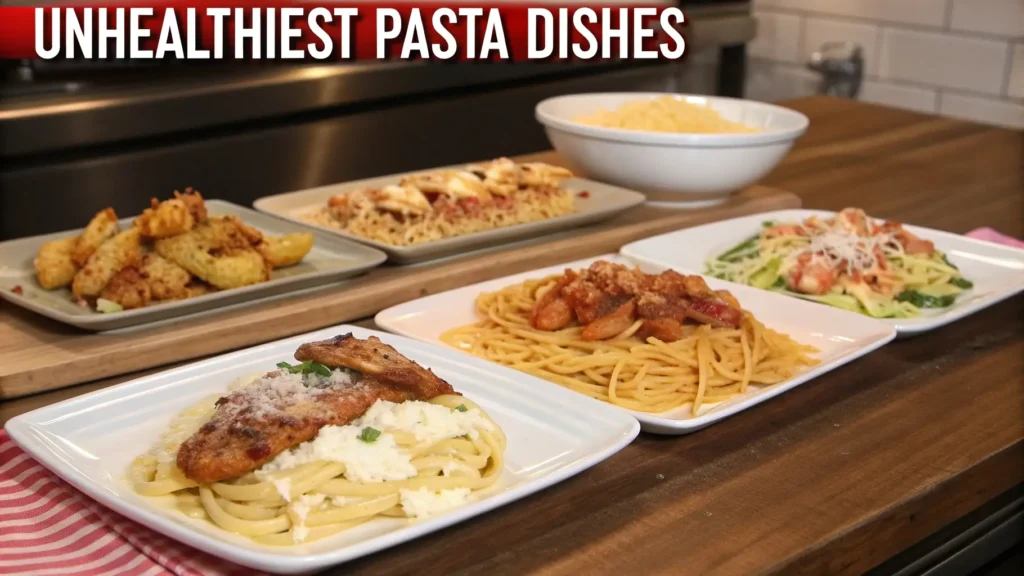Pasta is a beloved comfort food, gracing tables worldwide with its versatile flavors and undeniable charm. From hearty sauces to delicate seasonings, it can fit into countless cuisines. But not all pasta dishes are created equal—some hide a nutritional nightmare beneath their creamy exteriors. This article dives deep into answering the question, “What is the unhealthiest pasta dish?” You’ll uncover the criteria for unhealthy pasta, top offenders, and how to make smarter choices without sacrificing taste.

Introduction to Pasta and Health
Why Pasta is a Staple in Global Cuisine
Few foods rival pasta’s universal appeal. Whether it’s spaghetti marinara in Italy or creamy fettuccine Alfredo in the U.S., pasta’s versatility is unmatched. Its affordability and ability to pair with various sauces, proteins, and vegetables make it a culinary cornerstone. Packed with carbohydrates, it provides quick energy, making it a popular choice for meals.
Yet, this simple dish often takes a decadent turn when loaded with heavy cream, cheese, and other high-calorie ingredients. What starts as a humble plate of pasta can quickly become a calorie-laden indulgence.
The Dark Side: Hidden Calories and Unhealthy Additions
The problem isn’t pasta itself—it’s what we add to it. Rich, creamy sauces like Alfredo or carbonara pack an overwhelming punch of saturated fats and sodium. Cheese-stuffed ravioli, bacon bits, and large servings further escalate its caloric impact. Some pasta dishes served in restaurants can easily surpass a full day’s worth of calories in one sitting!
Shockingly, many of these decadent dishes come with deceptive names like “homemade” or “classic,” masking their unhealthy nature. Understanding these hidden pitfalls is key to navigating the pasta world more healthfully.
In the next section, we’ll explore what makes certain pasta dishes nutritional disasters and how you can spot the worst offenders.
What Defines an Unhealthy Pasta Dish?

Key Nutritional Red Flags
When answering “What is the unhealthiest pasta dish?”, it’s essential to identify the red flags. Excessive saturated fat is a top concern, often coming from heavy cream, butter, and cheese. These ingredients not only inflate calorie counts but also contribute to heart-health risks. Sodium, another major culprit, is prevalent in sauces and pre-packaged pasta meals, leading to water retention and increased blood pressure.
Another factor is portion size. Many restaurant dishes boast oversized servings, sometimes containing more than double the recommended daily intake of calories. Coupled with sugary add-ins like sweet tomato sauces, unhealthy pasta options become a diet disaster.
Ingredients That Transform a Dish into a Caloric Bomb
While pasta itself is often just flour and water, the real trouble lies in the toppings and sauces. Alfredo sauce, for instance, combines cream, butter, and cheese for a rich but unhealthy mix. Similarly, carbonara relies on bacon and egg yolks, spiking its saturated fat levels.
Stuffed pastas, like ravioli or tortellini, add another layer of indulgence. Filled with ricotta or ground meats, these dishes frequently incorporate fatty, processed ingredients. Pairing them with breadsticks or sugary soft drinks at a restaurant only worsens the nutritional profile.
How Preparation Methods Affect Healthiness
The way pasta is prepared can make a world of difference. Fried pasta dishes, like breaded and deep-fried lasagna bites, introduce trans fats. Overcooking pasta until it’s mushy increases its glycemic index, spiking blood sugar levels. On the other hand, al dente preparation retains more nutrients and stabilizes blood sugar. Being mindful of these details helps determine the healthiest and unhealthiest pasta options.
Top Contenders for the Unhealthiest Pasta Dish

Alfredo Sauce-Based Pastas
Alfredo dishes are often the first to come to mind when asking, “What is the unhealthiest pasta dish?” A typical serving of fettuccine Alfredo can pack over 1,200 calories and 75 grams of fat, thanks to its heavy cream and butter. The dish’s velvety texture hides shocking amounts of cholesterol and sodium, making it a common offender.
Carbonara: Cream and Bacon Overload
Carbonara offers a tantalizing blend of bacon, cheese, and egg yolks. While delicious, it’s a nutritional minefield. One plate can easily exceed 1,000 calories, with saturated fats accounting for a significant portion. The bacon alone adds sodium and nitrates, making it less than ideal for regular consumption.
Restaurant Specials That Go Overboard
Many chain restaurants take indulgence to the extreme with their pasta dishes. Cheesecake Factory’s Pasta Napoletana, for example, includes sausage, bacon, and Parmesan cream sauce, totaling over 2,300 calories—more than a day’s worth of energy in one meal!
Fast-Food Pasta Nightmares
Fast food chains have their share of pasta fails too. Mac and cheese bowls loaded with extra cheese and meats are particularly egregious. These dishes often contain trans fats and artificial flavorings, making them some of the unhealthiest options around.
In the next section, we’ll zoom in on specific pasta dishes to break down their nutrition profiles and offer tips on how to make smarter choices.
Breaking Down the Unhealthiest Dish: Case Studies
Analysis of the Worst Offender by Caloric and Nutritional Content
When analyzing “What is the unhealthiest pasta dish?”, dishes like Cheesecake Factory’s Pasta Napoletana take the lead. This caloric bomb contains sausage, bacon, and Parmesan cream sauce, clocking in at over 2,300 calories and nearly 80 grams of saturated fat. The sodium levels alone exceed 4,000 mg, doubling the recommended daily intake.
Breaking it down further, a single serving provides excessive amounts of unhealthy fats and salts, which can lead to heart disease and hypertension. The oversized portion also adds to the health concerns, making it a prime example of how pasta dishes can spiral out of control nutritionally.
Comparative Study: Home-Made vs. Restaurant Varieties
There’s a stark contrast between homemade and restaurant pasta dishes. Homemade options allow for better control over ingredients, portion sizes, and preparation methods. For instance, using whole-grain pasta and a light marinara sauce significantly reduces the calorie count compared to restaurant versions like Alfredo or Carbonara.
In contrast, restaurant dishes are designed to be indulgent, often adding extra butter, cream, and even sugar to sauces for flavor. This indulgence comes at the cost of health, making restaurant versions far less nutritious.
Healthier Pasta Alternatives and Tips
Swap Out Sauces for Healthier Choices
You don’t have to give up pasta to stay healthy. Swapping heavy cream-based sauces for marinara, pesto, or olive oil-based sauces can slash calorie and fat content. For instance, marinara sauce is low in fat and packed with antioxidants from tomatoes, making it a much healthier choice.
Protein-Packed Pastas and Whole Grains
Another way to make pasta healthier is by choosing whole-grain or legume-based pasta. These options are rich in fiber and protein, which help with digestion and provide sustained energy. Adding lean proteins like grilled chicken or shrimp can also elevate the dish nutritionally without overloading on calories.
Portion Control: Enjoying Pasta Without Overindulging
Finally, portion control is key. Restaurants often serve double or triple the recommended serving size. Stick to a fist-sized portion of pasta, and balance your plate with vegetables and protein. By doing so, you can enjoy your favorite dishes without feeling guilty.
Part 6: FAQs
Can Pasta Be Healthy?
Yes, pasta can be part of a healthy diet if you choose wisely. Whole-grain pasta, packed with fiber and nutrients, is a great alternative to traditional refined varieties. Pairing it with vegetable-based sauces or lean proteins further boosts its healthiness. However, when asked “What is the unhealthiest pasta dish?”, the focus shifts to dishes laden with heavy creams, cheeses, and oversized portions.
What Are the Worst Ingredients in Unhealthy Pasta Dishes?
The unhealthiest pasta dishes often include ingredients like Alfredo sauce, bacon, sausage, and processed cheese. These elements are high in saturated fats and sodium, which contribute to weight gain and other health risks. Dishes like carbonara or sausage-stuffed ravioli exemplify how these ingredients can transform pasta into a calorie bomb.
How to Identify a Balanced Pasta Meal?
A balanced pasta meal includes a proper serving size (about 1 cup of cooked pasta), whole-grain or legume-based noodles, and nutrient-rich toppings. Look for dishes featuring fresh vegetables, lean proteins, and light sauces like marinara or olive oil. Avoid menu items with terms like “loaded” or “stuffed,” as they often indicate high-calorie, high-fat meals.
Conclusion and Final Thoughts
Pasta can either be a healthy, nourishing meal or a nutritional disaster. Answering “What is the unhealthiest pasta dish?” reveals that the culprits lie in ingredients like heavy cream, processed meats, and oversized portions. Restaurant dishes, such as Alfredo or carbonara, frequently top the list due to their shocking calorie, fat, and sodium content.
However, making mindful choices can transform this comfort food into a guilt-free indulgence. Swapping refined pasta for whole grains, choosing vegetable-based sauces, and controlling portions are simple yet effective strategies. By doing so, you can enjoy the flavors you love without sacrificing your health.
For more inspiration on crafting balanced meals, don’t forget to visit our recipe collection and discover exciting ways to keep your meals both healthy and satisfying!

